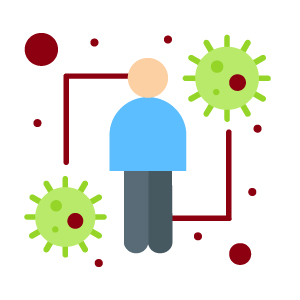Frame: bats and emerging infectious diseases
The COVID-19 pandemic has highlighted the serious risk of diseases jumping from animals to humans, particularly from wildlife. Among mammals, bats are special in terms of evolutionary history, ecology, biology, and immunology. As a consequence, they play primary roles in the maintenance and evolution of several viral families, some of which include viral species able to cause severe disease in humans. It is more and more clear that ecological disruptions like habitat loss and chemical exposure can increase the likelihood for bat viruses to be transmitted to humans. However, these viruses must overcome several barriers before emerging, including the overlap between the natural and the accidental hosts (humans and domestic animals), their interaction, the exposure of the accidental host based on the shedding route and timing, and the ability to infect and spread the new host.
In Europe, bats carry lyssaviruses, filoviruses, and coronaviruses that pose concerns for cross-species transmission due to their genetic correlation with human pathogens. Nevertheless, their zoonotic potential has not been fully uncovered, especially regarding bat coronaviruses and filoviruses, and there is no exhaustive information on the effectiveness of available vaccines and therapeutic agents to mitigate risks of infection. Comprehensive monitoring and understanding of emerging bat-related viruses are crucial for mitigating future health threats. It is essential to bridge data gaps and establish surveillance networks to assess and manage potential risks for public health more effectively. In order to address this situation, it is particularly important to never forget the host, tailoring surveillance and mitigation strategies on the specific bat species involved. For this reason, OneBAT will focus on a single bat species, providing species-specific knowledge, resources, and solutions. This approach aims to protect public health without harming these endangered animals, which are essential parts of our ecosystem.
Project
The OneBAT project aims to safeguard public health by studying viruses in European bats. Instead of just focusing on the viruses, the project looks at all steps leading to their transmission to humans. This “One World One Health” approach aligns with global efforts to be prepared for health emergencies.
With limited resources for disease research, OneBAT prioritizes three high-risk viruses, specifically coronaviruses, filoviruses and Iyssaviruses, associated with a specific bat species in Europe, the endangered Miniopterus schreibersii. This unique focus on one bat species optimizes efforts for efficient fieldwork and diagnostics.
OneBAT not only targets specific viruses but also prepares for unknown threats (Disease X) that could cause international epidemics. By studying viral families with different characteristics, the project aims to understand and predict how these viruses might emerge and spread. The goal is to be ready for future challenges, including potential new viruses (Virus X), ensuring global health safety.


Onebat: The Miniopterus schreibersii
The Schreibers’ long-fingered bat Miniopterus schreibersii (Kuhl, 1819), is a medium-sized winged marvel with a wingspan ranging from 24 to 30 centimeters. From Portugal to the Caucasus, and recently spotted in Poland, this bat is at the forefront of our OneBAT project, unveiling insights into its ecological importance and potential public health implications.
With distinctive brown or gray fur and uniquely bent wings, the long-fingered bat stands out in the natural tapestry. This bat’s long-distance migrations act as a natural genetic mixer among populations. As urban areas encroach upon its habitat, understanding its behavior becomes crucial, bridging the gap between the wild and urban landscapes. Beyond its natural wonder, the long-fingered bat brings public health considerations to the forefront. It’s associated with viruses that belong to the genus Lyssavirus and to the families Coronaviridae and Filoviridae. These viral groups are considered high priority because they include human viruses with high lethality and/or pandemic potential including Rabies virus, SARS-CoV-2 and Ebola virus. In this context, it is crucial to asses the specific potential of the viruses found in our target bat, that is now still mostly unknown, to infect, cause disease and spread among humans.
Objectives
The primary objective of OneBAT is to investigate viral spillover from bats, specifically targeting lyssaviruses, coronaviruses and filoviruses harboured by the endangered Miniopterus schreibersii to advance our understanding and develop therapeutic tools for Disease X, while establishing a methodological platform for ecological and virological investigations.
Impacts

Reducing the Impact of Emerging Diseases
By studying viruses in European bats, we aim to spot potential threats early, helping us manage and control situations where diseases might jump from bats to humans or other animals.

Improving Health Outcomes
The project seeks to decrease the negative health impact of specific viruses (lyssaviruses, filoviruses and coronaviruses) by developing tools for early detection, prevention, and treatment.

Strengthening Global Health Collaboration
By enhancing the know-how and diagnostic capabilities, the project aims to have more countries collaborating with eachothers to combat infectious diseases on a global scale.

Protecting Resources for Other Health Challenges
Unexpected infectious diseases can strain healthcare resources. OneBAT project aims to prevent this strain, ensuring resources are available for addressing other health issues like HIV, malaria, and tuberculosis.

Empowering People to Make Informed Choices
Increase awareness about infectious diseases associated with bats. Training specific groups, such as bat enthusiasts, will help people avoid behaviors that could lead to disease transmission. Moreover, OneBAT intends to share information about bats, promoting coexistence while respecting and preserving these animals.


